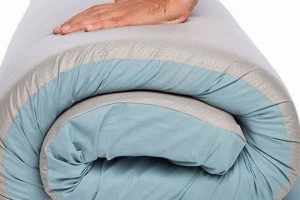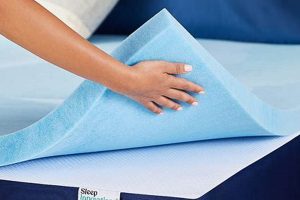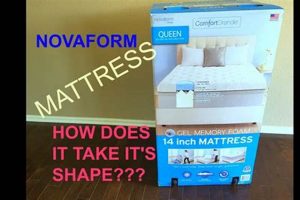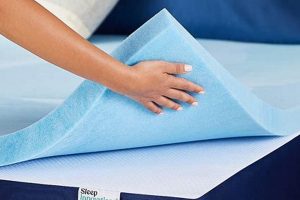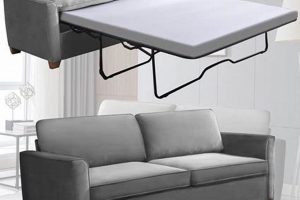The act of utilizing an inflatable bed for rest involves lying upon a sealed, flexible structure filled with air. This method of temporary bedding is commonly employed when traditional mattresses are unavailable or impractical, such as during camping trips, hosting guests, or in situations requiring portable sleep solutions. Its defining characteristic is its ability to be deflated and stored compactly when not in use.
The convenience and portability offered by inflatable beds contribute significantly to their popularity. They provide a readily accessible sleep surface that can be quickly deployed, offering a degree of comfort and support where conventional beds are not feasible. Throughout history, variations of inflatable sleeping surfaces have been used, evolving from basic air-filled sacks to more sophisticated designs incorporating internal support structures and durable materials.
The following discussion will delve into aspects such as the construction and materials used in inflatable beds, considerations for selecting the optimal model, factors affecting sleep quality, and maintenance strategies to ensure longevity and hygiene.
Enhancing Comfort and Longevity
Optimizing the experience and extending the lifespan of an inflatable bed requires careful consideration and proactive measures. The following guidelines provide a framework for maximizing comfort, ensuring proper support, and mitigating potential damage.
Tip 1: Surface Preparation is Crucial. Prior to inflation, inspect the intended placement area for sharp objects, debris, or uneven surfaces. A protective layer, such as a blanket or tarp, can minimize the risk of punctures and abrasion.
Tip 2: Regulate Inflation Pressure. Over-inflation can compromise the structural integrity of the bed and lead to seam failure. Inflate to the recommended pressure, typically indicated on the product label, and monitor for expansion under weight.
Tip 3: Employ a Mattress Topper for Enhanced Comfort. The addition of a memory foam or quilted mattress topper can significantly improve comfort levels by providing enhanced cushioning and reducing pressure points. This also aids in temperature regulation.
Tip 4: Maintain Consistent Temperature. Extreme temperature fluctuations can affect the air pressure within the bed, potentially causing expansion or contraction. Avoid placing it in direct sunlight or near heating vents.
Tip 5: Rotate Sleeping Positions. To distribute weight evenly and minimize localized stress, periodically adjust sleeping positions. This can help prevent the formation of soft spots or uneven wear.
Tip 6: Implement Regular Cleaning Protocols. Use a mild detergent and a damp cloth to clean the surface regularly. This prevents the accumulation of dirt, sweat, and allergens, which can degrade the material and affect hygiene.
Tip 7: Store Properly When Not in Use. Deflate the bed completely, fold it neatly, and store it in a cool, dry place away from direct sunlight. Using the original storage bag can protect it from dust and physical damage.
These strategies collectively contribute to a more comfortable and durable sleeping arrangement, extending the usable life of the inflatable bed and maximizing its utility.
The subsequent sections will address specific product features, repair techniques, and alternative bedding options to further enhance the understanding and practical application of this portable sleep solution.
1. Portability
Portability is a paramount consideration in evaluating the utility of an inflatable bed. Its capacity for compact storage and ease of transport distinguishes it from traditional bedding solutions, rendering it suitable for a range of applications where spatial constraints or mobility are primary concerns.
- Weight and Packed Size
The weight and packed dimensions of an inflatable bed directly correlate with its portability. Lighter models that compress to a smaller volume are inherently more convenient to transport, particularly for activities such as camping or travel. Variations in material thickness, internal structure, and integrated pump mechanisms contribute to the overall weight and packed size.
- Ease of Inflation and Deflation
The speed and simplicity of inflation and deflation processes affect the practical portability of an inflatable bed. Models equipped with integrated electric pumps offer rapid inflation, whereas those requiring manual inflation necessitate additional effort and time. Similarly, efficient deflation mechanisms facilitate quicker packing and storage. Self-inflating models also minimize user effort.
- Carrying and Storage Solutions
The availability of dedicated carrying bags or integrated storage solutions further enhances portability. A durable carrying bag protects the deflated bed from damage during transport and simplifies handling. Some models incorporate straps or handles for added convenience.
- Suitability for Different Environments
The portability of an inflatable bed dictates its suitability for various environments, ranging from indoor guest accommodations to outdoor camping scenarios. Compact and lightweight models are particularly advantageous for backpacking or situations where weight restrictions are imposed.
The multifaceted nature of portability, encompassing weight, packed size, ease of inflation/deflation, and carrying solutions, significantly influences the applicability of inflatable beds across diverse contexts. The selection of an appropriate model requires a thorough assessment of these factors in relation to the intended use case.
2. Inflation Level
The degree of inflation in an inflatable bed is a critical determinant of comfort, support, and overall sleep quality. Achieving the appropriate inflation level is paramount to realizing the intended benefits of this type of bedding system.
- Support and Spinal Alignment
Insufficient inflation leads to inadequate support, resulting in spinal misalignment and potential back pain. Conversely, over-inflation creates an excessively rigid surface, also detrimental to spinal alignment. The ideal inflation level provides a balance, allowing the spine to maintain its natural curvature during rest.
- Pressure Distribution
The inflation level directly impacts the distribution of pressure across the body. Inadequate inflation can concentrate pressure on bony prominences, increasing the risk of discomfort and potential pressure sores, particularly for individuals with limited mobility. Proper inflation ensures even weight distribution, minimizing localized pressure points.
- Firmness Preferences
Individual preferences for firmness vary significantly. Some individuals prefer a firmer sleep surface, which necessitates a higher inflation level, while others prefer a softer surface, requiring a lower inflation level. The ability to adjust the inflation level allows for customization to accommodate these preferences.
- Environmental Factors
Ambient temperature fluctuations can affect the air pressure within the bed. A drop in temperature can cause the air to contract, leading to reduced firmness, while an increase in temperature can cause expansion, potentially over-inflating the bed. Adjustments to the inflation level may be necessary to compensate for these environmental effects.
Therefore, precise management of the inflation level is integral to optimizing the experience of utilizing an inflatable bed. Careful consideration of support requirements, pressure distribution, personal preferences, and environmental factors enables the user to achieve a sleep surface that promotes comfort, proper spinal alignment, and overall well-being.
3. Surface Material
The surface material of an inflatable bed significantly influences the user’s sleep experience, dictating factors such as comfort, breathability, and durability. The choice of material directly impacts tactile sensations, thermal regulation, and the overall longevity of the product.
- Tactile Comfort and Skin Interaction
The outermost layer of the inflatable bed dictates the immediate tactile experience. Materials such as flocked vinyl offer a soft, suede-like texture that minimizes friction and enhances comfort against the skin. Conversely, bare vinyl surfaces can feel sticky or uncomfortable, especially in warm environments. The texture and composition of the surface material directly influence the user’s perception of comfort.
- Breathability and Temperature Regulation
Certain surface materials promote better airflow and moisture wicking, contributing to enhanced breathability. Flocked surfaces, while offering a softer feel, may retain heat. Materials with a smoother, less porous surface tend to be cooler. The breathability of the surface material significantly affects temperature regulation and the overall sleep environment, particularly in warmer climates.
- Durability and Resistance to Wear
The surface material’s durability dictates the bed’s resistance to punctures, abrasions, and general wear and tear. Thicker, more robust materials provide greater protection against damage, extending the lifespan of the product. The quality of the surface material is a primary determinant of its ability to withstand repeated use and handling.
- Cleanability and Maintenance
The ease with which the surface material can be cleaned and maintained is a practical consideration. Materials that are resistant to stains and easy to wipe down simplify hygiene maintenance. Flocked surfaces, while comfortable, may be more challenging to clean due to their textured nature. The ease of cleaning contributes to the long-term usability and hygiene of the inflatable bed.
In summary, the selection of the surface material is a crucial factor in determining the overall suitability of an inflatable bed for a particular user or application. Careful consideration of tactile comfort, breathability, durability, and cleanability ensures that the chosen material aligns with the intended use case and desired sleep experience. The surface material is a direct interface between the user and the inflatable bed, therefore its quality is of paramount importance.
4. Support structure
The support structure within an inflatable bed is a critical determinant of its overall performance and suitability for extended use. Unlike traditional mattresses that rely on springs, foam, or other rigid materials for support, inflatable beds utilize internal air chambers, baffles, or coil systems to distribute weight and maintain structural integrity. The effectiveness of this support structure directly impacts spinal alignment, pressure distribution, and the prevention of sagging, which can lead to discomfort and compromised sleep quality. Examples of support structures include horizontal or vertical air chambers, interconnected coil systems, and reinforced edges. The implementation of a robust support structure mitigates the tendency for the bed to conform excessively to the body’s contours, thereby promoting a more stable and supportive sleep surface. Without adequate internal support, an inflatable bed will likely exhibit uneven weight distribution, leading to localized pressure points and a general feeling of instability.
The practical significance of a well-designed support structure becomes evident when considering the diverse range of individuals who may utilize an inflatable bed. For heavier individuals, a robust support system is essential to prevent bottoming out and maintain adequate spinal alignment. Similarly, individuals with pre-existing back conditions require consistent support to minimize discomfort and promote restful sleep. The choice of support structure also influences the bed’s ability to accommodate movement during sleep; more sophisticated systems minimize motion transfer, preventing disturbances to a sleeping partner. Furthermore, the durability of the support structure directly affects the bed’s lifespan. Over time, repeated use can stress the internal seams and baffles, potentially leading to leaks or structural failures. Reinforced designs and durable materials are essential for ensuring long-term performance.
In conclusion, the support structure represents a fundamental component of any inflatable bed, significantly impacting its comfort, stability, and durability. A well-designed and implemented support system promotes proper spinal alignment, even weight distribution, and long-term reliability. The absence of adequate internal support compromises the sleep experience and reduces the bed’s suitability for extended use. While inflatable beds offer convenience and portability, the integration of a robust support structure is paramount to achieving a satisfactory and sustainable sleep solution.
5. Temperature Regulation
Temperature regulation presents a significant consideration when utilizing an inflatable bed. Unlike traditional mattresses, inflatable beds often lack the inherent thermal mass to effectively moderate temperature fluctuations. This characteristic stems from the composition and structure of inflatable beds, which primarily consist of a thin layer of material encasing a volume of air. Consequently, ambient temperature has a more pronounced effect on the sleep surface, leading to potential discomfort. In colder environments, the air within the bed can cool rapidly, resulting in a cold sleeping surface. Conversely, in warmer conditions, the air can heat up, causing the bed to become uncomfortably warm. This lack of thermal inertia necessitates proactive strategies to mitigate temperature extremes.
The material properties of the inflatable bed also influence temperature regulation. Vinyl, a common material in inflatable bed construction, is not breathable, which can exacerbate temperature-related issues. Moisture from perspiration can become trapped between the body and the bed surface, leading to a clammy and uncomfortable sensation. This lack of breathability can be particularly problematic in humid climates. The use of a mattress topper made of breathable materials such as cotton or wool can help to improve air circulation and reduce moisture buildup. Furthermore, selecting an inflatable bed with a flocked surface can enhance comfort by providing a softer and more absorbent layer. However, flocked surfaces may also retain heat, requiring careful consideration of the ambient temperature. Example: During summer months using a cotton sheet on an inflatable bed will feel much cooler when sleeping then not. This helps regulate the user temperature.
In conclusion, effective temperature management is crucial for optimizing the sleep experience on an inflatable bed. The inherent lack of thermal mass and breathability can create challenges, but these can be addressed through strategic use of bedding materials and awareness of environmental conditions. Failure to address temperature regulation can result in discomfort and disrupted sleep. The selection of appropriate bedding and proactive adjustments based on ambient temperature are essential for maximizing the utility of inflatable beds in diverse environments.
6. Durability concerns
The inherent nature of inflatable beds, relying on air pressure for structural support, renders them susceptible to a range of durability concerns. These concerns directly impact the lifespan, reliability, and overall suitability for sustained use. Punctures, seam failures, and material degradation represent primary sources of vulnerability, each potentially compromising the bed’s functionality and requiring repair or replacement. The thinness of the material, typically PVC or similar polymers, makes inflatable beds inherently more vulnerable to sharp objects or abrasive surfaces than traditional mattresses. Seam construction, often relying on adhesives or heat welding, represents a potential point of failure under stress, particularly with repeated inflation and deflation cycles. Material degradation, accelerated by exposure to sunlight, temperature fluctuations, and prolonged use, can lead to reduced elasticity and increased susceptibility to tears and leaks. The frequency and intensity of use are key factors influencing the manifestation of these durability concerns.
Real-world examples underscore the practical significance of durability concerns. Campers encountering unforeseen sharp objects on the ground may experience sudden deflation, rendering the bed unusable. Guests relying on an inflatable bed for temporary accommodation may face unexpected seam failures, resulting in discomfort and inconvenience. Individuals using inflatable beds for extended periods may observe gradual air loss due to microscopic leaks or material stretching, requiring frequent re-inflation. The quality of materials and construction techniques directly influences the severity and frequency of these issues. Higher-quality inflatable beds, constructed with reinforced materials and robust seam designs, exhibit greater resistance to damage and a longer lifespan. Proper maintenance, including careful handling, storage, and the use of protective layers, can mitigate some durability risks, but the fundamental vulnerability of inflatable beds remains a consideration. Selecting models tailored to the intended use case, considering factors such as weight capacity, material thickness, and seam reinforcement, is essential for minimizing durability-related problems.
In summary, durability concerns constitute a significant aspect of sleeping on an air mattress. The inherent vulnerability to punctures, seam failures, and material degradation dictates the need for careful selection, proper maintenance, and realistic expectations regarding lifespan. While inflatable beds offer portability and convenience, their long-term reliability is intrinsically linked to the quality of materials, construction techniques, and the intensity of use. Understanding these durability concerns allows for informed decision-making and proactive measures to mitigate potential problems, thereby maximizing the utility and longevity of inflatable beds in various applications.
7. Storage Efficiency
The characteristic of inflatable beds to be deflated and compactly stored when not in use fundamentally defines their utility in scenarios where space is a premium. This aspect of storage efficiency is not merely a convenience; it is a core feature that distinguishes inflatable beds from traditional mattresses, influencing their suitability for various applications.
- Deflation and Compression Mechanisms
The design and functionality of deflation mechanisms dictate the ease and speed with which an inflatable bed can be prepared for storage. Models incorporating electric pumps with reverse functionality expedite this process, while those relying solely on manual deflation may require more effort. The ability to fully compress the deflated bed is contingent on the effectiveness of these mechanisms, influencing the final packed size and, consequently, storage efficiency.
- Packed Volume and Dimensional Footprint
The volume occupied by a deflated and packed inflatable bed directly correlates with its storage efficiency. Beds designed for portability often prioritize minimal packed dimensions, employing thinner materials and streamlined construction. The resulting reduction in volume facilitates storage in confined spaces, such as closets, car trunks, or camping gear containers. This dimensional footprint is a critical consideration for individuals with limited storage capacity.
- Integrated Storage Solutions
The inclusion of dedicated storage bags or integrated carrying systems further enhances storage efficiency. A well-designed storage bag not only protects the deflated bed from damage but also provides a structured means of containment, preventing uncontrolled expansion and simplifying handling. Integrated straps or handles facilitate convenient carrying and stacking, optimizing space utilization during storage.
- Comparison with Traditional Bedding
The storage efficiency of inflatable beds stands in stark contrast to that of traditional mattresses, which occupy a fixed volume regardless of use. The ability to deflate and store an inflatable bed when not needed frees up valuable floor space, making it an attractive option for temporary accommodations, guest rooms, or situations where multi-functional spaces are desired. This distinction highlights the unique value proposition of inflatable beds in space-constrained environments.
In conclusion, storage efficiency represents a defining characteristic of inflatable beds, significantly impacting their practical utility and appeal. The ability to deflate and compactly store these beds addresses a critical need in space-limited environments, making them a versatile alternative to traditional bedding solutions. The design features, compression mechanisms, and integrated storage solutions all contribute to maximizing storage efficiency, underscoring its importance in the overall value proposition of inflatable beds.
Frequently Asked Questions
The following addresses common inquiries and misconceptions surrounding the use of inflatable beds, offering objective information for informed decision-making.
Question 1: Are inflatable beds suitable for long-term sleeping arrangements?
Inflatable beds are generally not recommended for sustained, long-term use as primary sleeping surfaces. Their support and durability characteristics typically do not match those of traditional mattresses designed for nightly use over extended periods.
Question 2: What measures can be taken to improve the comfort of an inflatable bed?
Comfort can be enhanced by employing a mattress topper made of memory foam or quilted material, ensuring adequate inflation pressure, and utilizing breathable bedding to regulate temperature.
Question 3: How can punctures be prevented in inflatable beds?
Punctures can be minimized by inspecting the placement area for sharp objects, using a protective layer beneath the bed, and avoiding over-inflation, which can stress the material.
Question 4: What is the typical lifespan of an inflatable bed?
The lifespan varies significantly depending on usage frequency, material quality, and maintenance practices. With proper care, a high-quality inflatable bed can last several years, but frequent use and inadequate maintenance can shorten its lifespan considerably.
Question 5: How should an inflatable bed be stored when not in use?
An inflatable bed should be fully deflated, folded neatly, and stored in a cool, dry place away from direct sunlight. Using the original storage bag can provide additional protection.
Question 6: Are all inflatable beds equally supportive?
No, the level of support varies based on internal construction, baffle design, and material thickness. Models with interconnected coils or reinforced internal structures typically offer greater support.
The information presented aims to provide a clear understanding of the capabilities and limitations of inflatable beds, enabling informed choices regarding their use and care.
The subsequent section will delve into alternative bedding solutions and their comparative advantages and disadvantages.
Sleeping on an Air Mattress
The preceding analysis has explored the multifaceted aspects of sleeping on an air mattress, encompassing considerations from comfort and durability to storage efficiency and temperature regulation. These factors collectively determine the suitability of inflatable beds for various applications, ranging from temporary guest accommodations to portable sleep solutions in outdoor environments. A comprehensive understanding of these elements is essential for making informed decisions regarding the selection, usage, and maintenance of inflatable beds.
Ultimately, the efficacy of sleeping on an air mattress is contingent upon aligning the product’s features with the specific needs and constraints of the user. While inflatable beds offer distinct advantages in terms of portability and storage, their inherent limitations in terms of support and durability necessitate careful consideration. Ongoing research and development in materials science and construction techniques hold the potential to enhance the performance and longevity of inflatable beds, expanding their applicability as viable sleeping solutions in diverse contexts.


